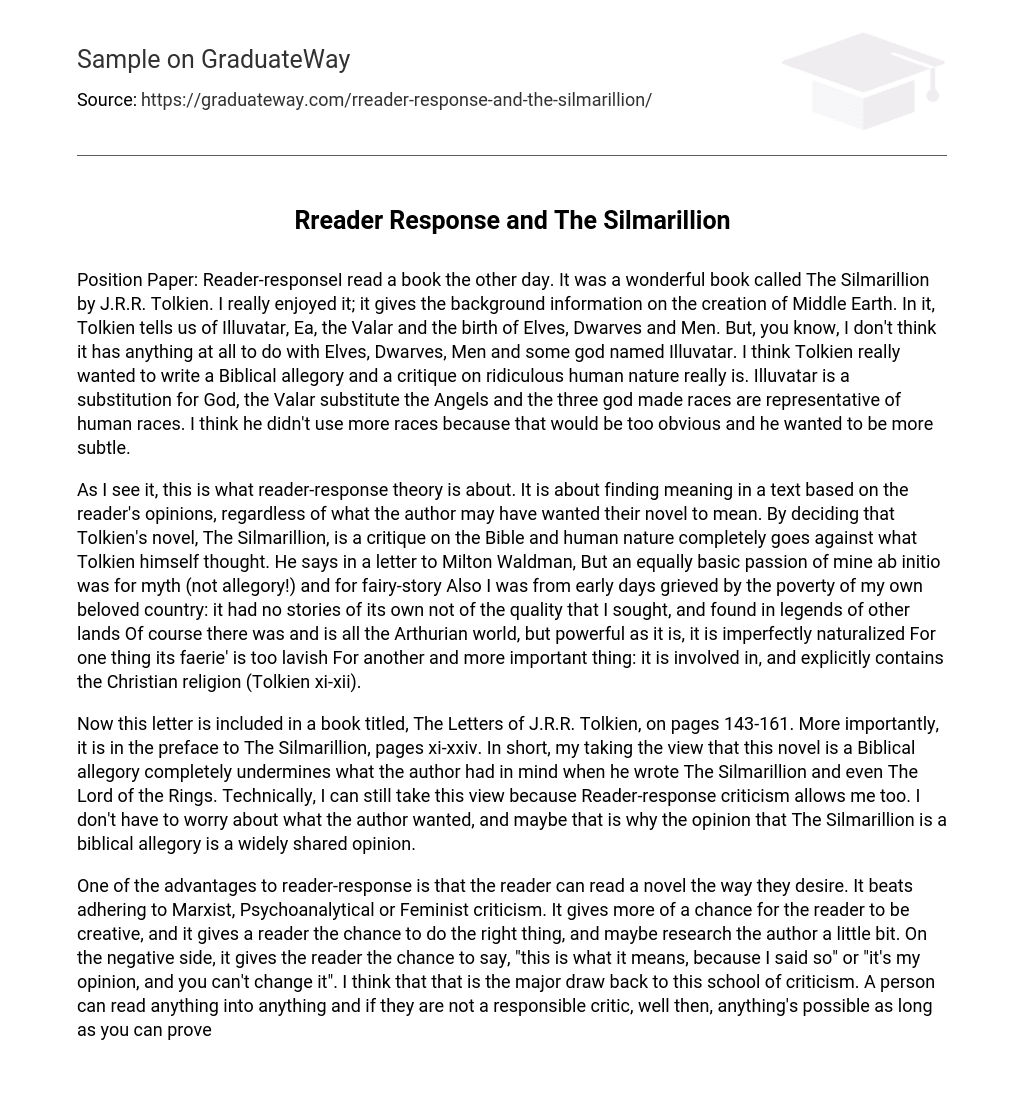Position Paper: Reader-responseI read a book the other day. It was a wonderful book called The Silmarillion by J.R.R. Tolkien. I really enjoyed it; it gives the background information on the creation of Middle Earth. In it, Tolkien tells us of Illuvatar, Ea, the Valar and the birth of Elves, Dwarves and Men. But, you know, I don’t think it has anything at all to do with Elves, Dwarves, Men and some god named Illuvatar. I think Tolkien really wanted to write a Biblical allegory and a critique on ridiculous human nature really is. Illuvatar is a substitution for God, the Valar substitute the Angels and the three god made races are representative of human races. I think he didn’t use more races because that would be too obvious and he wanted to be more subtle.
As I see it, this is what reader-response theory is about. It is about finding meaning in a text based on the reader’s opinions, regardless of what the author may have wanted their novel to mean. By deciding that Tolkien’s novel, The Silmarillion, is a critique on the Bible and human nature completely goes against what Tolkien himself thought. He says in a letter to Milton Waldman, But an equally basic passion of mine ab initio was for myth (not allegory!) and for fairy-story Also I was from early days grieved by the poverty of my own beloved country: it had no stories of its own not of the quality that I sought, and found in legends of other lands Of course there was and is all the Arthurian world, but powerful as it is, it is imperfectly naturalized For one thing its faerie’ is too lavish For another and more important thing: it is involved in, and explicitly contains the Christian religion (Tolkien xi-xii).
Now this letter is included in a book titled, The Letters of J.R.R. Tolkien, on pages 143-161. More importantly, it is in the preface to The Silmarillion, pages xi-xxiv. In short, my taking the view that this novel is a Biblical allegory completely undermines what the author had in mind when he wrote The Silmarillion and even The Lord of the Rings. Technically, I can still take this view because Reader-response criticism allows me too. I don’t have to worry about what the author wanted, and maybe that is why the opinion that The Silmarillion is a biblical allegory is a widely shared opinion.
One of the advantages to reader-response is that the reader can read a novel the way they desire. It beats adhering to Marxist, Psychoanalytical or Feminist criticism. It gives more of a chance for the reader to be creative, and it gives a reader the chance to do the right thing, and maybe research the author a little bit. On the negative side, it gives the reader the chance to say, “this is what it means, because I said so” or “it’s my opinion, and you can’t change it”. I think that that is the major draw back to this school of criticism. A person can read anything into anything and if they are not a responsible critic, well then, anything’s possible as long as you can prove it.
According to class notes, Reader-response takes root in the belief that the author writes the text and leaves gaps for the reader to fill in; it is a dance, a joint game between the reader and the author. This is the cooperative view to which Iser and Ingarden subscribed. On the other side of the coin is the subjectivist view, to which Holland and Bleich subscribe. This view states that the reader does all the work of creating, it is totally up to the reader to give the text meaning.
Any time I read a book, I can consider this view. Either side of the coin works for me. Whether I say that, Tolkien for example, left me clues in his novel but never told me what it was about so that reading it, we could collaborate and I could conclude that it was allegorical. Or whether I say that Tolkien just wrote letters on pages and I am left to my own devices in order to find a meaning, I can still apply whatever meaning I want to his text. Now for someone like me, who does not understand criticism well, this is great. Moreover, since I am of the opinion that a reader has to be responsible and do things correctly, maybe, I can stick to this school if I want to analyze anything. However, for someone who doesn’t care they might take advantage of the minimal rules this school has to offer, and give an impossible meaning to a text, such as, The Silmarillion is a biblical allegory.





